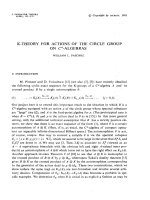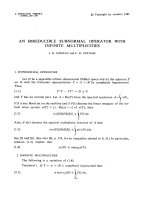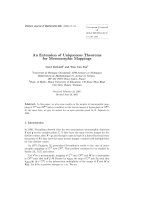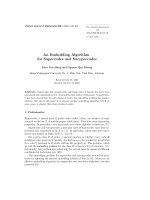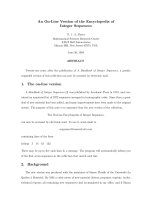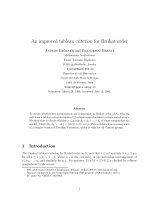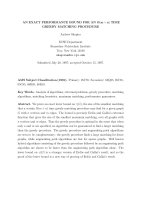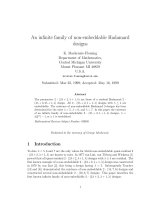Báo cáo toán học: "an Identity Generator: Basic Commutator" pdf
Bạn đang xem bản rút gọn của tài liệu. Xem và tải ngay bản đầy đủ của tài liệu tại đây (93.69 KB, 6 trang )
An Identity Generator: Basic Commutators
M. Farrokhi D. G.
Institute of Mathematics
University of Tsukuba
Tsukuba Ibaraki 305, Japan
Submitted: Feb 23, 2008; Accepted: Apr 26, 2008; Published: May 5, 2008
Mathematics Subject Classification: Primary 05A19, 68R15; Secondary 11B39, 20E05
Abstract
We introduce a group theoretical tool on which one can derive a family of iden-
tities from sequences that are defined by a recursive relation. As an illustration it
is shown that
n−1
i=1
F
n−i
F
2
i
=
1
2
n
i=1
(−1)
n−i
(F
2i
− F
i
) =
F
n+1
2
−
F
n
2
,
where {F
n
} denotes the sequence of Fibonacci numbers.
1 Preliminaries and Introduction
We start our work with recalling some basic facts about the structural properties of words
in a free group; cf. [1]. Let F be the free group generated by the set X = {x
1
, . . . , x
n
}.
Marshall Hall [1] introduced a family of words in F , which are known as basic commutators
and play an essential role. Every basic commutator u has a weight, denoted by ω(u), which
is a natural number. Also, the basic commutators can be ordered generally with respect
to their weight.
Definition. (Basic Commutators)
1) x
1
, . . . , x
n
are basic commutators of weight 1 and are ordered with respect to each
other (here x
1
< · · · < x
n
),
2) if the basic commutators of weights less than n are defined, then the basic commu-
tators of weight n are w = [u, v] = u
−1
v
−1
uv, where
i) u, v are basic commutators and ω(u) + ω(v) = n,
ii) u > v and if u = [s, t] then t ≤ v.
If ω(u) < n then u < w. The basic commutators of weight n are ordered arbitrarily
with respect to each other.
the electronic journal of combinatorics 15 (2008), #N15 1
The following theorem of Marshall Hall plays a basic role in the study of basic commu-
tators. Recall that the commutator subgroups γ
k
(G) in a group G are defined recursively
by γ
1
(G) = G and
γ
i+1
(G) = [γ
i
(G), G] = [x, g]; x ∈ γ
i
(G), g ∈ G,
for all i ≥ 1. We refer the reader to [1] for some basic properties of γ
k
(G).
Theorem 1.1. (Marshall Hall [1, Theorem 11.2.4]) If F is the free group with free gener-
ators x
1
, . . . , x
n
and if c
1
, . . . , c
m
is the sequence of basic commutators of weights 1, . . . , k,
then an arbitrary element w of F has a unique representation
w = c
a
1
1
· · · c
a
m
m
(mod γ
k+1
(F )),
where a
1
, . . . , a
m
are integers. Moreover, the basic commutators of weight k form a basis
for the free abelian group γ
k
(F )/γ
k+1
(F ).
In this paper, we introduce a general strategy on the discovery of almost number
theoretical identities using a word-based combinatorics. As an illustration it is shown
that
n−1
i=1
F
n−i
F
2
i
=
1
2
n
i=1
(−1)
n−i
(F
2i
− F
i
) =
F
n+1
2
−
F
n
2
,
where {F
n
} denotes the sequence of Fibonacci numbers.
2 Main Results
To explain our method, let F be the free group of finite rank generated by X and {w
n
}
be a recursively defined sequence of words in F . Also, let k ≥ 1 and c
1
, . . . , c
m
be the
sequence of basic commutators of weights 1, . . . , k. Then, by Theorem 1.1, w
n
has a
unique representation
w
n
= c
a
1,n
1
· · · c
a
m,n
m
(mod γ
k+1
(F )), (1)
where a
1,n
, . . . , a
m,n
are integers. Since {w
n
} is recursively defined, we may assume that
w
n
= W
n
(w
1
, . . . , w
n−1
, X), where W
n
is a word on w
1
, . . . , w
n−1
and elements of X.
Suppose that i ≥ 1 and a
j,k
’s are known for all j such that ω(c
j
) < ω(c
i
) and all k ≥ 1.
Feeding the representation (1) of w
1
, . . . , w
n−1
in w
n
one observes that a
i,n
can be obtained
recursively by a
i,1
, . . . , a
i,n−1
, i.e., {a
i,n
}
∞
n=1
is also a recursive sequence. Now, by solving
the recursive sequences {w
n
} and {a
i,n
}
∞
n=1
, we obtain a
i,n
in two different forms from
which we obtain an identity. An identity which is obtained in this way is called the c
i
-
identity of {w
n
}. It is evident that different methods in solving the sequences {w
n
} and
{a
i,n
}
∞
n=1
would give different identities. To be more tangible what it means, in Theorem
2.2 we obtain a [y, x]-identity in details.
Throughout this paper, F denotes the free group of rank 2 generated by x and y.
In this case, x < y < [y, x] would denotes the basic commutators of weights 1, 1, 2,
the electronic journal of combinatorics 15 (2008), #N15 2
respectively. In what follows we use frequently the well-known identities yx = xy[y, x],
[xy, z] = [x, z]
y
[x, z] and [x, yz] = [x, z][x, y]
z
, where x, y and z are elements of an arbitrary
group G. As a direct consequence of these identities we can prove
Lemma 2.1. For any group G and elements x, y ∈ G
i) y
n
x
m
= x
m
y
n
[y, x]
mn
(mod γ
3
(G));
ii) (xy)
n
= x
n
y
n
[y, x]
(
n
2
)
(mod γ
3
(G)).
Now, we explain the first example in details. Let w
1
= x
a
y
c
, w
2
= x
b
y
d
and w
n+2
=
w
u
n
w
v
n+1
, where a, b, c, d, u, v are integers and n ≥ 0. Also, let
¯
F = F/γ
3
(F ) and ¯w =
wγ
3
(F ), for each w ∈ F . Then, by Theorem 1.1, there are unique integers a
n
, b
n
and c
n
such that
¯w
n
= ¯x
a
n
¯y
b
n
[¯y, ¯x]
c
n
,
for all n ≥ 1.
To obtain the [y, x]-identity of {w
n
} we need some more notations. To do this, let
{L
n
}, {L
n
} be the sequences recursively defined by the rules L
n+2
= uL
n
+ vL
n+1
and
L
n+2
= uL
n
+ vL
n+1
, where L
0
= 0, L
1
= u, L
0
= 1, L
1
= v and n ≥ 0. Moreover,
Let {G
n
}, {G
n
} be sequences recursively defined by G
n+2
= uG
n
+ vG
n+1
and G
n+2
=
uG
n
+ vG
n+1
, where G
1
= a, G
2
= b, G
1
= c, G
2
= d and n ≥ 1.
Utilising the notations above, we have
Theorem 2.2.
n
i=1
L
n−i
u
2
G
i
G
i
+
v
2
G
i+1
G
i+1
+ uvG
i+1
G
i
(2)
= u
n
i=1
(−u)
n−i
L
i−1
L
i−1
+ v
L
i−1
2
a b
c d
+ ac
L
n
2
+ bd
L
n
2
+ bcL
n
L
n
,
for all n ≥ 1
To prove Theorem 2.2, we need the following lemmas.
Lemma 2.3. If n ≥ 0, then L
n+1
= uL
n
and L
n+1
= L
n
+ vL
n
.
Proof. By definition L
1
= u = uL
0
, L
2
= uv = uL
1
, L
1
= v = L
0
+vL
0
and L
2
= u+v
2
=
L
1
+ vL
1
. Now, if n > 1 and the result hold for n − 2 and n − 1, then
L
n+2
= uL
n
+ vL
n+1
= u(uL
n−1
+ vL
n
) = uL
n+1
,
L
n+2
= uL
n
+ vL
n+1
= L
n+1
+ vL
n+1
,
as required.
Lemma 2.4. Let k and n be nonnegative integers. Then
i) ¯w
k
n
= ¯x
ka
n
¯y
kb
n
[¯y, ¯x]
kc
n
+
(
k
2
)
a
n
b
n
;
ii) [ ¯w
n+1
, ¯w
n
] = [¯y, ¯x]
(−u)
n−1
(ad−bc)
.
the electronic journal of combinatorics 15 (2008), #N15 3
Proof. i) It is obvious by Lemma 2.1(ii).
ii) If n = 1, then [ ¯w
n+1
, ¯w
n
] = [ ¯w
2
, ¯w
1
] = [¯x
b
¯y
d
, ¯x
a
¯y
c
] = [¯y, ¯x]
ad−bc
. Now, if n > 1, then
[ ¯w
n+1
, ¯w
n
] = [ ¯w
u
n−1
¯w
v
n
, ¯w
n
] = [ ¯w
n
, ¯w
n−1
]
−u
and the result follows inductively.
Proof of Theorem 2.2. To prove identity (2), we calculate c
n+2
in two different ways.
1) First, we count c
n+2
directly by solving {c
n
}. If n ≥ 1, then by Lemmas 2.1(i) and
2.4(i)
¯w
n+2
= ¯w
u
n
¯w
v
n+1
= ¯x
ua
n
¯y
ub
n
[¯y, ¯x]
uc
n
+
(
u
2
)
a
n
b
n
¯x
va
n+1
¯y
vb
n+1
[¯y, ¯x]
vc
n+1
+
(
v
2
)
a
n+1
b
n+1
= ¯x
ua
n
¯y
ub
n
¯x
va
n+1
¯y
vb
n+1
[¯y, ¯x]
uc
n
+vc
n+1
+
(
u
2
)
a
n
b
n
+
(
v
2
)
a
n+1
b
n+1
= ¯x
ua
n
¯x
va
n+1
¯y
ub
n
[¯y, ¯x]
uva
n+1
b
n
¯y
vb
n+1
[¯y, ¯x]
uc
n
+vc
n+1
+
(
u
2
)
a
n
b
n
+
(
v
2
)
a
n+1
b
n+1
= ¯x
ua
n
+va
n+1
¯y
ub
n
+vb
n+1
[¯y, ¯x]
uc
n
+vc
n+1
+
(
u
2
)
a
n
b
n
+
(
v
2
)
a
n+1
b
n+1
+uva
n+1
b
n
.
Hence
a
n+2
= ua
n
+ va
n+1
,
b
n+2
= ub
n
+ vb
n+1
,
c
n+2
= uc
n
+ vc
n+1
+
u
2
a
n
b
n
+
v
2
a
n+1
b
n+1
+ uva
n+1
b
n
.
It follows from the definitions of {a
k
}, {b
k
} and {G
k
}, {G
k
} that a
k
= G
k
and b
k
= G
k
,
for all k ≥ 1. Let d
k+2
=
u
2
a
k
b
k
+
v
2
a
k+1
b
k+1
+ uva
k+1
b
k
, for all k ≥ 1. Then c
n+2
=
uc
n
+ vc
n+1
+ d
n+2
= L
1
c
n
+ L
1
c
n+1
+ L
0
d
n+2
. Now, suppose that 1 ≤ k < n and
c
n+2
= L
k
c
n−k+1
+ L
k
c
n−k+2
+ L
k−1
d
n−k+3
+ · · · + L
0
d
n+2
.
Then
c
n+2
= L
k
c
n−k+1
+ L
k
c
n−k+2
+ L
k−1
d
n−k+3
+ · · · + L
0
d
n+2
= L
k
c
n−k+1
+ L
k
(uc
n−k
+ vc
n−k+1
+ d
n−k+2
) + L
k−1
d
n−k+3
+ · · · + L
0
d
n+2
= L
k+1
c
n−k
+ L
k+1
c
n−k+1
+ L
k
d
n−k+2
+ · · · + L
0
d
n+2
and so by induction we obtain
c
n+2
= L
n
c
1
+ L
n
c
2
+ L
n−1
d
3
+ · · · + L
0
d
n+2
= L
n−1
d
3
+ · · · + L
0
d
n+2
=
n
i=1
L
n−i
d
i+2
,
as c
1
= c
2
= 0. Therefore
c
n+2
=
n
i=1
L
n−i
u
2
G
i
G
i
+
v
2
G
i+1
G
i+1
+ uvG
i+1
G
i
. (3)
the electronic journal of combinatorics 15 (2008), #N15 4
2) Now, we count c
n+2
in a different way by solving {w
n
}. Put
α
i
= (−u)
n−i
uL
i−1
L
i−1
+ uv
L
i−1
2
a b
c d
,
for i = 1, . . . , n. Clearly α
1
= 0 and so ¯w
n+2
= ¯w
u
n
¯w
v
n+1
= ¯w
L
1
n
¯w
L
1
n+1
[¯y, ¯x]
α
1
. We will show
that for i = 1, . . . , n,
¯w
n+2
= ¯w
L
i
n−i+1
¯w
L
i
n−i+2
[¯y, ¯x]
α
1
+···+α
i
. (4)
If (4) holds for i, then using Lemmas 2.1(i,ii) and 2.4(ii)
¯w
n+2
= ¯w
L
i
n−i+1
¯w
L
i
n−i+2
[¯y, ¯x]
α
1
+···+α
i
= ¯w
L
i
n−i+1
( ¯w
u
n−i
¯w
v
n−i+1
)
L
i
[¯y, ¯x]
α
1
+···+α
i
= ¯w
L
i
n−i+1
¯w
uL
i
n−i
¯w
vL
i
n−i+1
[ ¯w
v
n−i+1
, ¯w
u
n−i
]
(
L
i
2
)
[¯y, ¯x]
α
1
+···+α
i
= ¯w
L
i
n−i+1
¯w
uL
i
n−i
¯w
vL
i
n−i+1
[¯y, ¯x]
α
1
+···+α
i
+(−u)
n−i−1
uv
(
L
i
2
)
(ad−bc)
= ¯w
uL
i
n−i
¯w
L
i
n−i+1
[ ¯w
L
i
n−i+1
, ¯w
uL
i
n−i
] ¯w
vL
i
n−i+1
[¯y, ¯x]
α
1
+···+α
i
+(−u)
n−(i+1)
uv
(
L
i
2
)
(ad−bc)
= ¯w
uL
i
n−i
¯w
L
i
+vL
i
n−i+1
[¯y, ¯x]
α
1
+···+α
i
+(−u)
n−(i+1)
“
uL
i
L
i
+uv
(
L
i
2
)
”
(ad−bc)
= ¯w
L
i+1
n−i
¯w
L
i+1
n−i+1
[¯y, ¯x]
α
1
+···+α
i+1
.
By replacing i by n in (4) and using Lemma 2.1(i,ii), we get
¯w
n+2
= ¯w
L
n
1
¯w
L
n
2
[¯y, ¯x]
α
1
+···+α
n
= (x
a
y
c
)
L
n
(x
b
y
d
)
L
n
[¯y, ¯x]
α
1
+···+α
n
= x
aL
n
y
cL
n
x
bL
n
y
dL
n
[¯y, ¯x]
α
1
+···+α
n
+ac
(
L
n
2
)
+bd
(
L
n
2
)
= x
aL
n
+bL
n
y
cL
n
+dL
n
[¯y, ¯x]
α
1
+···+α
n
+ac
(
L
n
2
)
+bd
(
L
n
2
)
+bcL
n
L
n
.
Therefore
c
n+2
= α
1
+ · · · + α
n
+ ac
L
n
2
+ bd
L
n
2
+ bcL
n
L
n
. (5)
Now, the equations (3) and (5) imply the identity (2), which is the [y, x]-identity of
{w
n
}.
Corollary 2.5. For any n > 0
n−1
i=1
F
n−i
F
2
i
=
1
2
n
i=1
(−1)
n−i
(F
2i
− F
i
). (6)
Proof. By putting u = v = a = d = 1 and b = c = 0 in identity (2), we get L
n
= F
n
,
L
n
= F
n+1
, G
n
= F
n−2
, G
n
= F
n−1
and so
n
i=1
F
n+1−i
F
2
i−1
=
n
i=1
(−1)
n−i
F
i−1
F
i
+
F
i
2
.
the electronic journal of combinatorics 15 (2008), #N15 5
Now,
n
i=1
F
n+1−i
F
2
i−1
=
n−1
i=1
F
n−i
F
2
i
and F
i−1
F
i
+
F
i
2
=
1
2
(F
2i
− F
i
), which completes
the proof.
Corollary 2.6. For any n > 0
n−1
i=1
F
n−i
F
i
F
i+1
=
F
n+1
2
. (7)
Proof. Put u = v = a = b = d = 1 and c = 0 in identity (2).
Corollary 2.7. For any n > 0
n−1
i=1
F
n−i
F
2
i
=
F
n+1
2
−
F
n
2
. (8)
Proof. By Corollary 2.6, we have
n−1
i=1
F
n−i
F
2
i
=
n−1
i=1
F
n−i
F
i
(F
i+1
− F
i−1
)
=
n−1
i=1
F
n−i
F
i
F
i+1
−
n−1
i=1
F
n−i
F
i
F
i−1
=
n−1
i=1
F
n−i
F
i
F
i+1
−
n−2
i=1
F
n−1−i
F
i
F
i+1
=
F
n+1
2
−
F
n
2
.
Similar to Corollary 2.7, one we can prove the following result.
Corollary 2.8. For any n > 0
n−1
i=1
F
n−i
F
2i
=
F
n
2
+
F
n+1
2
. (9)
Acknowledgment. The author would like to thank the referee for some useful suggestions
and corrections.
References
[1] M. Hall, The Theory of Groups, Macmillan, New York, 1955.
the electronic journal of combinatorics 15 (2008), #N15 6
